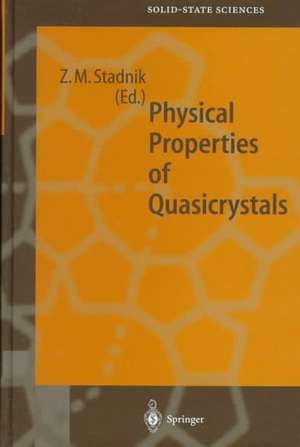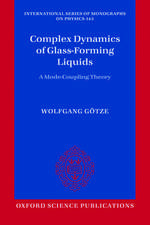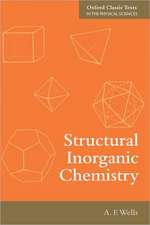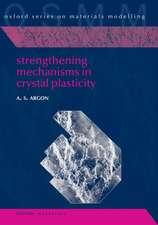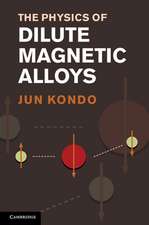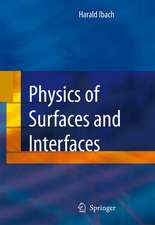Physical Properties of Quasicrystals: Springer Series in Solid-State Sciences, cartea 126
Editat de Zbigniew M. Stadniken Limba Engleză Hardback – 30 noi 1998
| Toate formatele și edițiile | Preț | Express |
|---|---|---|
| Paperback (1) | 1388.22 lei 6-8 săpt. | |
| Springer Berlin, Heidelberg – 6 noi 2012 | 1388.22 lei 6-8 săpt. | |
| Hardback (1) | 1231.01 lei 6-8 săpt. | |
| Springer Berlin, Heidelberg – 30 noi 1998 | 1231.01 lei 6-8 săpt. |
Din seria Springer Series in Solid-State Sciences
- 18%
 Preț: 1225.94 lei
Preț: 1225.94 lei - 18%
 Preț: 1017.62 lei
Preț: 1017.62 lei - 15%
 Preț: 532.05 lei
Preț: 532.05 lei - 18%
 Preț: 944.51 lei
Preț: 944.51 lei -
 Preț: 541.47 lei
Preț: 541.47 lei - 18%
 Preț: 956.96 lei
Preț: 956.96 lei -
 Preț: 385.84 lei
Preț: 385.84 lei - 18%
 Preț: 1827.48 lei
Preț: 1827.48 lei - 15%
 Preț: 661.02 lei
Preț: 661.02 lei -
 Preț: 389.88 lei
Preț: 389.88 lei - 15%
 Preț: 639.59 lei
Preț: 639.59 lei - 15%
 Preț: 635.15 lei
Preț: 635.15 lei - 18%
 Preț: 896.21 lei
Preț: 896.21 lei - 15%
 Preț: 647.92 lei
Preț: 647.92 lei - 15%
 Preț: 651.34 lei
Preț: 651.34 lei - 18%
 Preț: 890.23 lei
Preț: 890.23 lei - 15%
 Preț: 640.55 lei
Preț: 640.55 lei - 15%
 Preț: 649.54 lei
Preț: 649.54 lei - 15%
 Preț: 645.60 lei
Preț: 645.60 lei - 15%
 Preț: 644.30 lei
Preț: 644.30 lei - 15%
 Preț: 653.79 lei
Preț: 653.79 lei - 18%
 Preț: 956.69 lei
Preț: 956.69 lei - 15%
 Preț: 637.59 lei
Preț: 637.59 lei - 23%
 Preț: 1043.42 lei
Preț: 1043.42 lei - 15%
 Preț: 639.08 lei
Preț: 639.08 lei - 15%
 Preț: 648.24 lei
Preț: 648.24 lei - 15%
 Preț: 637.46 lei
Preț: 637.46 lei - 15%
 Preț: 640.06 lei
Preț: 640.06 lei -
 Preț: 391.40 lei
Preț: 391.40 lei -
 Preț: 390.84 lei
Preț: 390.84 lei - 15%
 Preț: 638.57 lei
Preț: 638.57 lei - 18%
 Preț: 1006.06 lei
Preț: 1006.06 lei - 18%
 Preț: 730.79 lei
Preț: 730.79 lei - 15%
 Preț: 640.37 lei
Preț: 640.37 lei - 15%
 Preț: 643.65 lei
Preț: 643.65 lei - 18%
 Preț: 950.21 lei
Preț: 950.21 lei - 15%
 Preț: 642.68 lei
Preț: 642.68 lei - 15%
 Preț: 640.55 lei
Preț: 640.55 lei - 18%
 Preț: 1229.10 lei
Preț: 1229.10 lei
Preț: 1231.01 lei
Preț vechi: 1501.23 lei
-18% Nou
Puncte Express: 1847
Preț estimativ în valută:
235.63€ • 256.03$ • 198.06£
235.63€ • 256.03$ • 198.06£
Carte tipărită la comandă
Livrare economică 22 aprilie-06 mai
Preluare comenzi: 021 569.72.76
Specificații
ISBN-13: 9783540651888
ISBN-10: 3540651888
Pagini: 464
Ilustrații: XVI, 443 p.
Dimensiuni: 155 x 235 x 30 mm
Greutate: 0.83 kg
Ediția:1999
Editura: Springer Berlin, Heidelberg
Colecția Springer
Seria Springer Series in Solid-State Sciences
Locul publicării:Berlin, Heidelberg, Germany
ISBN-10: 3540651888
Pagini: 464
Ilustrații: XVI, 443 p.
Dimensiuni: 155 x 235 x 30 mm
Greutate: 0.83 kg
Ediția:1999
Editura: Springer Berlin, Heidelberg
Colecția Springer
Seria Springer Series in Solid-State Sciences
Locul publicării:Berlin, Heidelberg, Germany
Public țintă
ResearchCuprins
1. Introduction.- References.- 2. Metallurgy of Quasicrystals.- 2.1 Introduction.- 2.2 Preparation of Quasicrystals.- 2.3 Structural Classification from Diffraction Patterns.- 2.4 Quasicrystalline Alloy Systems and the Formation of Quasicrystals.- 2.5 Phase Transformation from Amorphous to Icosahedral Phase.- 2.6 Phase Diagrams.- 2.7 Growth of Quasicrystals.- 2.8 Summary.- References.- 3. Crystallography of Quasicrystals.- 3.1 Introduction.- 3.2 N-Dimensional Description of Quasicrystals.- 3.3 One-Dimensional Quasicrystals.- 3.4 Decagonal Quasicrystals.- 3.5 Icosahedral Quasicrystals.- References.- 4. Experimental Determination of the Structure of Quasicrystals.- 4.1 Introduction.- 4.2 X-ray and Neutron Diffraction.- 4.3 Structure of the Al-Pd-Mn Icosahedral Phase.- 4.4 Structure of the Al-Ni-Co Decagonal Quasicrystal.- 4.5 Conclusions.- References.- 5. Electronic Transport Properties of Quasicrystals — Experimental Results.- 5.1 Introduction.- 5.2 Experimental Results.- 5.3 Towards Understanding Transport Properties.- 5.4 Concluding Remarks.- References.- 6. Theory of Electronic Structure in Quasicrystals.- 6.1 Introduction.- 6.2 Electronic Structure in One-and Two-Dimensional Quasilattices.- 6.3 Electronic Structure in Quasicrystals.- 6.4 Transport Properties in Quasicrystals.- 6.5 Summary.- References.- 7. Elementary Excitations and Physical Properties.- 7.1 Introduction.- 7.2 Quasiperiodicity, Symmetry, and Elementary Excitations.- 7.3 Modelling Quasicrystalline Structures and Approximant Phases.- 7.4 Numerical Characterization of Elementary Excitations.- 7.5 Phonons in Quasicrystals.- 7.6 Electrons in Quasicrystals.- 7.7 Final Remarks.- References.- 8. Spectroscopic Studies of the Electronic Structure.- 8.1 Introduction.- 8.2 Theoretical Predictions.- 8.3Experimental Results.- 8.4 Uniqueness of the Electronic Structure of Quasicrystals.- 8.5 Quasiperiodicity and Unusual Physical Properties.- 8.6 Conclusions and Outlook.- References.- 9. Magnetic Properties of Quasicrystals.- 9.1 Introduction.- 9.2 Al-Based Quasicrystals.- 9.3 Mg-RE-Zn Quasicrystals.- 9.4 Summary.- References.- 10. Surface Science of Quasicrystals.- 10.1 Introduction.- 10.2 Oxidized Surfaces.- 10.3 Surface Energies.- 10.4 Clean Surfaces.- 10.5 Friction.- 10.6 Concluding Remarks.- References.- 11. Mechanical Properties of Quasicrystals.- 11.1 Introduction.- 11.2 Low-Temperature Mechanical Properties.- 11.3 Dislocations in Quasicrystals.- 11.4 High-Temperature Plastic Deformation.- 11.5 Discussion.- 11.6 Concluding Remarks.- References.- 12. Toward Industrial Applications.- 12.1 Introduction.- 12.2 The Relevant Properties of Quasicrystals.- 12.3 Possible Applications.- 12.4 Conclusion.- References.
Textul de pe ultima copertă
Physical Properties of Quasicrystals presents an up-to-date introduction to the field of quasicrystals, a new form of matter which was discovered only in 1984. The field is inspected from an experimental point of view and the results are interpreted within the framework of the existing theoretical models. The book discusses our current understanding of the unusual physical properties of quasicrystals, as well as highlighting the challenges associated with the physical interpretation of the properties of these complex and fascinating materials. The book is written by a team of active researchers and conveys the sense of an excitement associated with research in a rapidly developing area of new alloys. A wealth of measured experimental data is presented and important information is given in a convenient tabular form. Although the book is aimed at a broad audience interested in the intriguing physical properties of these novel alloys, it will be of general use both to long-time workers in the field and uninitiated graduate students.
Caracteristici
This book is the most comprehensive book available on quasicrystals It contains the latest knowledge and applications of this new class of materials
